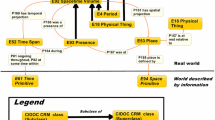Abstract
The World-Wide Web hosts many autonomous and heterogeneous information sources. In the near future each source may be described by its own ontology. The distributed nature of ontology development will lead to a large number of local ontologies covering overlapping domains. Ontology integration will then become an essential capability for effective interoperability and information sharing. Integration is known to be a hard problem, whose complexity increases particularly in the presence of spatiotemporal information. Space and time entail additional problems such as the heterogeneity of granularity used in representing spatial and temporal features. Spatio-temporal objects possess intrinsic characteristics that make then more complex to handle, and are usually related by specific relationships such as topological, metric and directional relations. The integration process must be enhanced to tackle mappings involving these complex spatiotemporal features. Recently, several tools have been developed to provide support for building mappings. The tools are usually based on heuristic approaches that identify structural and naming similarities [1]. They can be categorized by the type of inputs required for the analysis: descriptions of concepts in OBSERVER [2], concept hierarchies in iPrompt and AnchorPrompt [3] and instances of classes in GLUE [4] and FCA-Merge [5]. However, complex mappings, involving spatiotemporal features, require feedback from a user to further refine proposed mappings and to manually specify mappings not found by the tools.
Access this chapter
Tax calculation will be finalised at checkout
Purchases are for personal use only
Similar content being viewed by others
References
Staab, S., Studer, R. (eds.): Handbook on Ontologies. International Handbooks on Information Systems. Springer, Heidelberg (2004)
Mena, E., Illarramendi, A., Kashyap, V., Sheth, A.: OBSERVER: An Approach for Query Processing in Global Information Systems Based on Interoperation across Preexisting Ontologies. Distributed and Parallel Databases - An International Journal 8(2) (2000)
Noy, N.F., Musen, M.A.: Anchor-PROMPT: Using non-local context for semantic matching. In: Workshop on Ontologies and Information Sharing, IJCAI 2001 (2001)
Doan, A., Madhavan, J., Domingos, P., Halvey, A.Y.: Learning to Map between Ontologies on the Semantic Web. In: Proceedings of the Eleventh International World Wide Web Conference, WWW 2002, Hawaii, US (2002)
Stumme, G., Maedche, A.: FCA-MERGE: Bottom-Up Merging of Ontologies. In: Proc. of International Joint Conference on Automated Reasoning, IJCAR 2001 (2001)
Sotnykova, A., Monties, S., Spaccapietra, S.: Semantic Integration in MADS Conceptual Model. In: Bestougeff, H., Thuraisihgham, B. (eds.) Heterogeneous Information Exchange and Organizational Hubs, Kluwer, Dordrecht (2002)
Haarslev, V., Lutz, C., Möller, R.: A Description Logic with Concrete Domains and a Roleforming Predicate Operator. Journal of Logic and Computation 9(3) (1999)
Calvanese, D., De Giacomo, G., Lenzerini, M., Nardi, D., Rosati, R.: Description Logic Framework for Information Integration. In: Proc. of the 6th International Conference on the Principles of Knowledge Representation and Reasoning, Trento (I), June 2-5 (1998)
Sotnykova, A., Aufaure, M.-A., Bennacer, N., Cullot, N., Vangenot, C.: Semantic Mappings in Description Logics for Database Schema Integration. Journal of Database Semantics, Springer LNCS (submitted for publication)
Author information
Authors and Affiliations
Editor information
Editors and Affiliations
Rights and permissions
Copyright information
© 2004 Springer-Verlag Berlin Heidelberg
About this paper
Cite this paper
Bennacer, N., Aufaure, MA., Cullot, N., Sotnykova, A., Vangenot, C. (2004). Representing and Reasoning for Spatiotemporal Ontology Integration. In: Meersman, R., Tari, Z., Corsaro, A. (eds) On the Move to Meaningful Internet Systems 2004: OTM 2004 Workshops. OTM 2004. Lecture Notes in Computer Science, vol 3292. Springer, Berlin, Heidelberg. https://doi.org/10.1007/978-3-540-30470-8_14
Download citation
DOI: https://doi.org/10.1007/978-3-540-30470-8_14
Publisher Name: Springer, Berlin, Heidelberg
Print ISBN: 978-3-540-23664-1
Online ISBN: 978-3-540-30470-8
eBook Packages: Springer Book Archive




